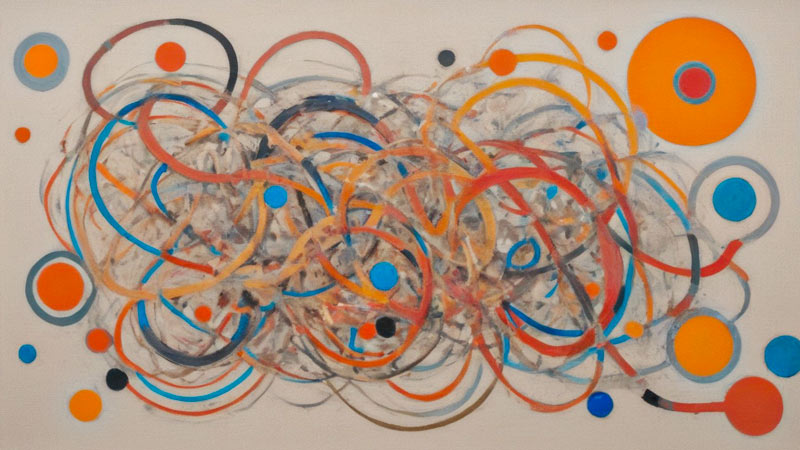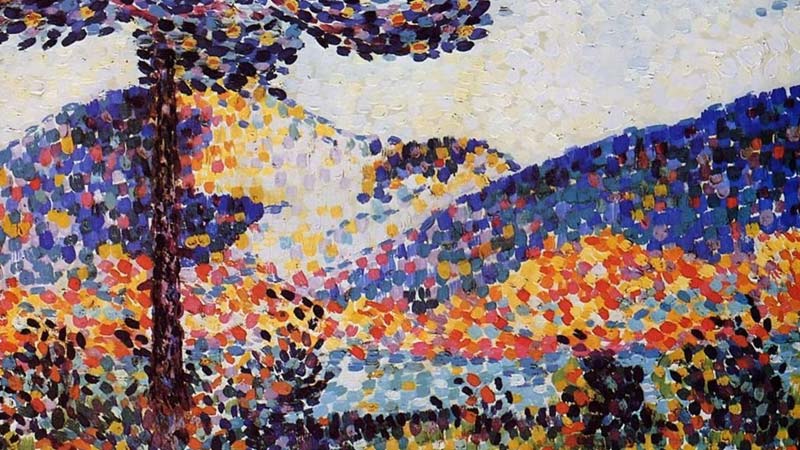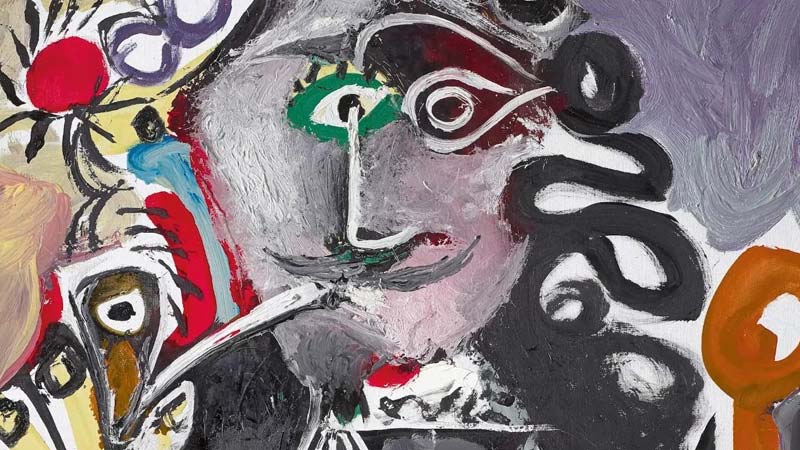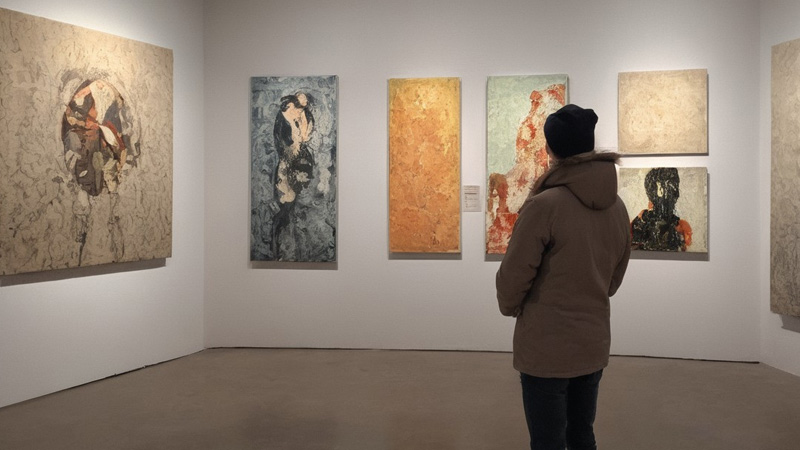Diving headfirst into the vibrant world of modern art, I find myself constantly amazed by its depth and diversity. It’s a realm that rejects conformity in favor of exploration, pushing boundaries to create new perspectives.
Modern art is not just about painting or sculpture, it’s a dynamic medium that includes performance, digital media and even architecture.
It’s easy to get lost in modern art’s myriad of styles. From surrealism with its dreamlike images to pop art’s bright commentary on popular culture, each movement has its unique charm and voice.
I particularly love how modern art can challenge our perceptions, making us question what we know and see.
As an expert blogger on this topic, I’ve had the privilege of experiencing many incredible works of art firsthand, and I’m excited to share my insights with you.
Whether you’re an established connoisseur or just starting your journey into modern art, there’s always something new to discover.

The Evolution of Modern Art
Modern art is a dynamic and ever-evolving realm that has undergone significant transformations over the past century.
From its roots in the late 19th century to its diverse manifestations in the contemporary era, modern art reflects the shifting landscapes of culture, society, and individual expression.
Emergence of Avant-Garde Movements
The late 19th century marked a departure from traditional artistic norms as avant-garde movements sought to break free from academic conventions:
Impressionism (Late 19th Century)
Artists like Monet and Renoir rebelled against the constraints of academic painting, prioritizing the capture of light and atmosphere in their works.
Post-Impressionism
Building upon Impressionism, artists such as Van Gogh and Gauguin explored heightened emotional expression through vibrant colors and symbolic imagery.
Fauvism
Matisse led Fauvist artists to use bold, non-naturalistic colors to convey intense emotions and subjective experiences.
Cubism
Picasso and Braque pioneered Cubism, deconstructing forms into geometric shapes and challenging traditional notions of perspective and representation.
Abstraction and Expressionism
The early 20th century witnessed a shift towards abstraction and subjective expression:
Abstract Expressionism (Mid-20th Century)
American artists like Pollock and Rothko embraced abstraction to express inner emotions and universal truths, often through gestural brushwork and non-representational forms.
Surrealism
Surrealist artists such as Dalí and Magritte explored the realm of the subconscious, creating dreamlike imagery and juxtaposing disparate elements to evoke psychological tension.
Expansion and Experimentation
In the latter half of the 20th century, modern art expanded into new territories and mediums:
Pop Art
Artists like Warhol and Lichtenstein appropriated imagery from popular culture, challenging distinctions between high and low art and critiquing consumerist society.
Minimalism
Minimalist artists like Judd and Stella reduced art to its essential elements, emphasizing simplicity, geometry, and spatial relationships.
Conceptual Art
Conceptual artists like Duchamp and Beuys prioritized ideas and concepts over traditional craftsmanship, blurring the boundaries between art and everyday objects or actions.
Performance Art
Practitioners like Abramović and Burden used their bodies as a medium for artistic expression, often pushing the limits of endurance, audience participation, and social commentary.
Contemporary Directions
In the 21st century, modern art continues to evolve in response to globalized culture, digital technology, and pressing social issues:
New Media and Digital Art
Artists utilize digital technologies, interactive installations, and virtual platforms to explore new modes of expression and engagement with audiences.
Socially-Engaged Art
Many contemporary artists address urgent social and political concerns through their work, advocating for activism, inclusivity, and environmental sustainability.
Hybrid Practices
Artists increasingly embrace interdisciplinary approaches, blending traditional artistic mediums with performance, installation, video, and sound elements.
Characteristics of Modern Art

Modern art is a multifaceted and dynamic form of expression that emerged in the late 19th and early 20th centuries, challenging traditional artistic conventions and paving the way for radical experimentation and innovation.
Here are some key characteristics that define modern art:
Breaking Tradition
Modern art boldly departed from traditional norms and conventions, embracing new techniques, subjects, and themes previously considered unconventional or taboo.
Experimentation with Form
Modern artists explored and manipulated shapes, figures, and perspectives, often resulting in abstract or non-representational styles such as Cubism, Surrealism, and Futurism. This experimentation challenged traditional notions of artistic representation.
Diversity in Mediums and Materials
Modern art expanded the range of materials and mediums used in artistic expression, going beyond traditional oil paints to include metal, wood, found objects, and even everyday items like soup cans.
This diversity led to movements like Dadaism and Pop Art, which embraced unconventional materials and mass-produced imagery.
Emphasis on Innovation
Modern artists prioritized innovation and pushing the boundaries of artistic expression. From Marcel Duchamp’s concept of Readymade to Jackson Pollock’s drip paintings, contemporary art constantly sought new ways to challenge societal norms and redefine the idea of art itself.
Personal Interpretation over Objective Understanding
Unlike traditional art forms, which often convey specific narratives or historical events, modern art encourages individual interpretation and subjective experiences.
Modern artworks are often open-ended, inviting viewers to engage with them and derive their meanings and interpretations.
Important Movements in Modern Art

A rich tapestry of movements characterizes modern art, each leaving an indelible mark on the artistic landscape.
From the vibrant hues of Fauvism to the enigmatic dreamscapes of Surrealism, these movements have shaped the aesthetics and ideologies of the art world.
Here are some pivotal moments in modern art history:
Fauvism
- Key Artists: Henri Matisse, André Derain
- Overview: Emerging at the dawn of the 20th century, Fauvism prized bold, non-naturalistic colors and emotional expression over realistic representation. Artists like Matisse and Derain used vivid hues to convey intense emotions, challenging traditional artistic conventions.
Cubism
- Key Artists: Pablo Picasso, Georges Braque
- Overview: Cubism, pioneered by Picasso and Braque, revolutionized how artists depicted form and space. Cubist artists introduced a new visual language that pushed the boundaries of traditional representation by breaking subjects down into geometric shapes and presenting multiple perspectives simultaneously.
Dada
- Key Artists: Marcel Duchamp, Hans Arp
- Overview: Born out of the chaos of World War I, Dadaism rejected established artistic norms and embraced absurdity and randomness. Artists like Duchamp challenged the very definition of art with readymade sculptures, provoking thought and controversy in equal measure.
Surrealism
- Key Artists: Salvador Dalí, René Magritte
- Overview: Surrealism delved into the depths of the subconscious mind, creating dreamlike imagery that defied logic and reason. Artists like Dalí and Magritte explored themes of dreams, fantasies, and the unconscious, captivating audiences with their enigmatic and thought-provoking works.
Abstract Expressionism
- Key Artists: Jackson Pollock, Mark Rothko
- Overview: Post-World War II, Abstract Expressionism emerged as a dominant force in the art world, placing America firmly on the global stage. Artists like Pollock and Rothko sought to express raw emotion through non-representational forms and bold color fields, pioneering a new era of artistic expression.
Influential Modern Artists
Exploring the rich tapestry of modern art unveils a pantheon of influential figures whose contributions have shaped the course of artistic history.
Here are some of the most prominent:
Pablo Picasso

- Notable Work: “Les Demoiselles d’Avignon”
- Artistic Style: Cubism
- Overview: Picasso’s revolutionary approach to Cubism shattered traditional notions of form and perspective, redefining the very essence of artistic expression. His bold exploration of geometric shapes and fragmented compositions challenged viewers to see the world in new and unconventional ways.
Jackson Pollock
- Notable Work: “No. 5, 1948”
- Artistic Style: Abstract Expressionism
- Overview: Pollock’s innovative “drip” technique transformed the canvas into a dynamic arena of gestural expression. His large-scale, abstract compositions captured the raw energy and spontaneity of the creative process, pushing the boundaries of painting and paving the way for the Abstract Expressionist movement.
Georgia O’Keeffe
- Notable Work: “Black Iris III”
- Artistic Style: American Modernism
- Overview: O’Keeffe’s iconic depictions of flowers, landscapes, and skyscrapers offered a fresh perspective on the American experience. Her bold use of color and form and her intimate connection to the natural world established her as a trailblazer for women in the arts and a leading figure in American Modernism.
Salvador Dali
- Notable Work: “The Persistence of Memory”
- Artistic Style: Surrealism
- Overview: Dali’s surrealistic paintings, characterized by dreamlike imagery and bizarre landscapes, challenged conventional notions of reality and perception. His exploration of the subconscious mind and fascination with symbolism captivated audiences worldwide, cementing his status as one of the most iconic artists of the 20th century.
The Impact of Modern Art on Society

Modern art is not just a collection of aesthetically pleasing images; it is a powerful force that shapes and reflects society’s cultural, social, and political landscape.
From its early beginnings to its contemporary manifestations, modern art has provoked thought, challenged conventions, and stimulated dialogue on various issues.
Here’s how modern art has made its mark on society:
Early 20th Century: Reflection of Societal Shifts
In the early 20th century, as society grappled with rapid industrialization and urbanization, modern artists like Wassily Kandinsky embraced abstraction to express the complexities and emotions evoked by these changes.
Abstract art mirrored the fragmentation and disorientation of modern life, reflecting the anxieties and uncertainties of the time.
Contemporary Social Commentary
Modern artists continue to use their work as a platform for social commentary, addressing pressing issues such as political corruption, environmental degradation, and wealth inequality.
Artists like Banksy create provocative street art that challenges the status quo and sparks conversations about important social and political issues.
Stimulating Dialogue and Debate
Modern art has always been a catalyst for debate and discussion, eliciting a wide range of reactions from viewers. While some may find modern art obscure or provocative, others see it as a necessary tool for stimulating dialogue and fostering critical thinking within society.
By pushing boundaries and challenging established norms, modern art encourages viewers to consider different perspectives and engage in meaningful discourse.
Fostering Societal Progress
Ultimately, the impact of modern art on society extends beyond the realm of aesthetics. Through its provocation and innovation, contemporary art plays a vital role in fostering societal progress by encouraging introspection, empathy, and understanding.
By confronting uncomfortable truths and raising awareness about pressing issues, modern art inspires individuals to take action and work toward positive change.
Conclusion
Delving into modern art has been a captivating journey, revealing its profound significance as a reflection of society and culture.
Each movement has reshaped artistic history and societal norms by challenging conventions from Cubism to Surrealism and Abstract Expressionism.
Renowned artists like Picasso and Pollock have contributed to the diverse tapestry of modern art, showcasing personal experiences and viewpoints. Its boldness and creativity continue to captivate audiences worldwide as contemporary art evolves.
Moving forward, in an increasingly digital era, the anticipation of how new techniques will reshape this vibrant field adds to the excitement. Whether enthusiast or skeptic, let’s continue exploring together, as modern art promises ever-fresh horizons.
Leave a Reply